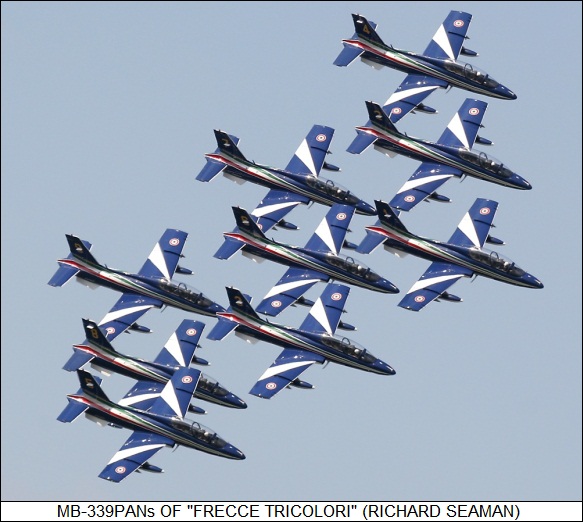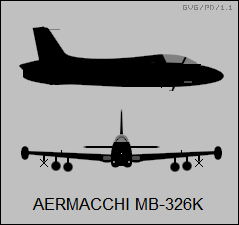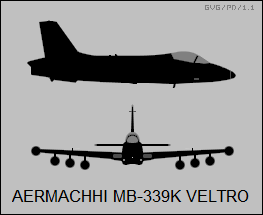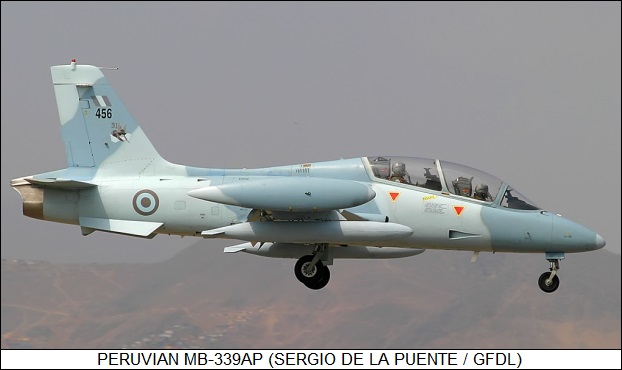
* In the postwar period, the Aermacchi aircraft company of Italy scored a big success with the popular "MB-326" trainer, which was built in large numbers and obtained by many air forces. The MB-326 led to a revamped derivative, the "MB-339", which was produced in good numbers. This document provides a history and description of the MB-326 and MB-339.

* In 1953, a team under Dr. Ermanno Bazzochi at Aermacchi began work on a new two-seat jet trainer that would also be suitable for light strike duties. The machine was to be easy to fly and easy to maintain. The Italian air force, the Aeronautica Militare Italiana (AMI), liked the design, authorizing the development program for the "MB-326" and ordering two flight prototypes, plus a static-test machine.
The first prototype performed its initial flight on 10 December 1957, with company chief test pilot Guido Carestiato at the controls. This machine was fitted with a Bristol Siddeley (later Rolls-Royce) Viper 8 turbojet providing 7.78 kN (795 kgp / 1,750 lbf) thrust. The first prototype proved clearly underpowered; the second prototype, which performed its initial flight on 22 September 1958, featured the more powerful Viper 11, with 11.12 kN (1,135 kgp / 2,500 lbf) thrust.
The first prototype was lost in an accident in Egypt during a foreign demonstration tour on 22 April 1959, with the pilot, Nicola Macchia, killed. The second prototype was demonstrated at the Le Bourget airshow in France in June 1959, where it impressed many potential buyers. By that time, pre-production machines were being built, the AMI having ordered a batch of 15 for evaluation in December 1958. The first pre-series machine performed its initial flight on 5 October 1960. Successful evaluation led to orders of what would end up being 118 MB-326 trainers for the AMI, with the type going into service in early 1962.
As it emerged, the MB-326 was a pleasing aircraft with smoothly contoured Italian style. It featured:
The cadet and instructor sat in tandem in a pressurized cockpit on lightweight ejection seats, with a one-piece canopy that hinged open to the right. The aircraft was sturdy, reliable, and handled well. It was given the affectionate nickname of "Macchino" -- "Little Macchi" -- in service. The MB-326 was so much fun to fly that flight instructors quickly put together an informal aerobatic team. The type set altitude, climb, and speed records for its class.
The initial-production trainers for the AMI are referred to with the designation of "MB-326A" in some sources, but the MB-326A was actually a concept for an armed weapons trainer that was unsuccessfully pitched to the AMI. A single prototype of an armed "MB-326B", with a gunsight and six underwing stores pylons for the light strike role, was built and evaluated by the AMI. The AMI didn't bite, with the MB-326B being converted to standard MB-326 trainer configuration, but the idea didn't go away. The "MB-326C" was a proposed "lead-in" trainer for the AMI Lockheed F-104G Starfighter, with the trainer featuring a "pointy nose" for F-104G NASARR radar, other Starfighter avionics, and a more powerful Viper 20 engine -- but the AMI acquired the two-seat TF-104G instead.

Aeritalia, the Italian national airline, needed to train pilots to fly the new jetliners and so followed the lead of the AMI, obtaining four examples of the "MB-326D", which was an MB-326 fitted with civilian radios and avionics. The first was delivered in the spring of 1963.
* Although the AMI had turned down the MB-326B armed variant, Aermacchi felt that smaller air forces might find an armed combination trainer / light strike aircraft very attractive. That assumption proved correct, with Tunisia becoming the first of many export users of the Macchino by purchasing eight MB-326Bs in 1965. In the same year, Ghana bought nine "MB-326F" machines, based on the MB-326B but with a more sophisticated avionics suite, underwing tank capability, and larger wingtip tanks.
These two deals were only a warmup. Later in 1965, Aermacchi signed a contract with South Africa for another MB-326B derivative, the "MB-326M", elegantly known as the "Impala Mark I" in South African Air Force (SAAF) service. It featured upgraded avionics and qualification for a wider range of underwing stores. Aermacchi built 46 MB-326Ms for the SAAF, with initial deliveries in 1966, and Atlas Aircraft Company of South Africa built 105 more into 1975, for a total buy of 151 MB-326Ms. The type would serve as the mount for the SAAF "Silver Falcons" aerobatic team, with their aircraft painted in shiny blue and silver colors.
Australia also jumped on board the Macchi bandwagon, obtaining the "MB-326H", another MB-326B derivative with more sophisticated avionics to Royal Australian Air Force (RAAF) spec; qualifications for RAAF external stores; and a Viper Mark 22-11 engine, with the same thrust as the Viper 11 but a more powerful starter-generator. Aermacchi built 21, with initial deliveries to Australia in 1967; Commonwealth Aircraft Corporation (CAC) of Australia then assembled or license-built 54 for the RAAF, and went on to build 12 more for the RAAF and ten for the Royal Australian Navy (RAN) -- giving a total of 97 MB-326Hs in Australian service. The MB-326H served Australia well into the 1990s, when it was replaced by the BAE Hawk trainer.
BACK_TO_TOP* Introduction of the uprated Viper 20 Mark 540 (Viper 20-540) engine with 15.17 kN (1,545 kgp / 3,410 lbf) thrust led to the development of the definitive "MB-326G", with the first of two prototypes performing its initial flight on 8 May 1967. The MB-326G featured larger engine intakes to provide more airflow to the engine, airframe reinforcements to permit higher loads, six underwing stores pylons, and an updated avionics suite. The external load was doubled.
___________________________________________________________________
AERMACCHI MB-326G:
___________________________________________________________________
wingspan:
10.15 meters (33 feet 4 inches)
wing area:
19.35 sq_meters (208.3 sq_feet)
length:
10.7 meters (35 feet)
height:
3.72 meters (12 feet 2 inch)
empty weight:
2,964 kilograms (6,534 pounds)
MTO weight:
5,897 kilograms (13,000 pounds)
max speed at altitude:
685 KPH (425 MPH / 370 KT)
service ceiling:
14,325 meters (47,000 feet)
combat radius:
650 kilometers (400 MI / 350 NMI)
___________________________________________________________________
The AMI didn't buy the MB-326G as such, but did obtain twelve hybrid "MB-326E" machines for weapons training from 1968. These were basically MB-326 trainers fitted with the MB-326G wing, a gunsight, gun camera, and some updated avionics. They generally flew with underwing cannon pods. Six of the MB-326Es were new-build aircraft, while six were updates of old MB-326 trainers.

The Macchino remained in frontline AMI service into the early 1980s, and was retained in second-line duties until 1990 -- when a pilot ejected from one and the machine decided to turn around and drop into a school, killing twelve students. The MB-326s were obviously becoming decrepit and had to be grounded -- but a dozen were refurbished for use as "hacks", and continued to fly well into the 1990s. Apparently the AMI liked the MB-326 so much that it was only given up with regret.
* There were many buyers for the MB-326G in the export market. The Argentine Navy was the first foreign customer, obtaining eight "MB-326GB" machines in 1969. Zaire (previously and now the Congo) obtained 17 MB.326GBs in the same year, though some sources claim only 15 were actually delivered. Zambia obtained 23 MB-326GBs in 1971.
The biggest deal for the MB-326G was with Brazil, with Aermacchi president Dott Foresio and Bazzochi taking a team to that nation in 1969 to sell the MB-326G to the Forca Aerea Brazil (FAB). The FAB liked the aircraft, and the first of 36 Aermacchi-built "MB-326GC" machines was delivered in 1971, with Embraer of Brazil then constructing 130 identical "EMB-326GC" machines for the FAB, for a total of 166 machines in FAB service. The Macchi was given the designation of "AT-26 Xavante" in Brazilian service, using the name of a Brazilian native tribe; some of the total were built to a reconnaissance specification, with the ability to carry and control a camera pod with four Vinten cameras, and these machines were given the designation of "RT-26". The last of them was retired from Brazilian service in 2010.
Embraer also built ten EMB-326GC / AT-26 machines for Paraguay, and six for Togo, with both receiving their aircraft in the early 1980s. These were new-build aircraft; the Argentine Navy also received eleven hand-me-downs from FAB stocks. The last EMB-326GC / AT-26 was built in 1983, this being the last MB-326 of any sort ever built. The FAB obtained 14 refurbished Impala Mark 2s -- discussed later -- from South Africa in 2005, along with three more in 2006, but retired all their Macchis in 2010.
BACK_TO_TOP* Following development of the MB-326G, Aermacchi decided to build a dedicated single-seat strike variant, the "MB-326", with cockpit armor, twin 30-millimeter revolver cannon installed in the belly of the aircraft under the cockpit, and a further uprated engine, the Viper 632-43, with 17.8 kN (1,815 kgp / 4,000 lbf) thrust. The Viper 632-43 was developed as a collaboration between Rolls-Royce and Fiat.
The initial flight of the first of two MB-326K prototypes was on 22 August 1970; it was fitted with the older Viper 20-540 engine, and British Aden cannon. The definitive second prototype performed its first flight in 1971. It was closer to production spec, featuring the Viper 632-43 engine and French DEFA cannon, with 125 rounds per gun.

The MB-326K also featured further airframe reinforcement, as well as hydraulically-boosted ailerons to improve control responsiveness. The MB-326K was fitted with six underwing stores pylons and could carry an external load of 1,815 kilograms (4,000 pounds), including machine gun or cannon pods; high-explosive and napalm bombs; unguided rocket pods; or a four-camera reconnaissance pod. It was qualified for the French Matra Magic heat-seeking air-to-air missile (AAM).
South Africa was interested in the MB-326K, the SAAF having used their MB-326M / Impala Mark 1 machines to good effect against insurgents. Aermacchi built 14 MB-326Ks for South Africa, the type being designated "Impala Mark 2" in SAAF service, with Atlas building 86 more, the last being delivered in 1982. The Impala Mark 2 had some differences from the "stock" MB-326K, most significantly fit of the older Viper 20-540 engine since Atlas officials didn't want to acquire a new license for engine construction. The last Impalas were phased out of South African service in 2005, with some sold to Brazil, as discussed earlier. They were also replaced by the BAE Hawk.
Aermacchi also built an improved two-seat trainer, the "MB-326L", which was essentially an MB-326G with the airframe improvements of the MB-326K; it is unclear if the MB-326L featured the Viper 632-43 engine or retained the older Viper 20-540 engine.
Dubai ordered six "MB-326KD" single-seaters and two "MB-326LD" two-seaters in 1975. The next year, Tunisia ordered seven "MB-326KT" single-seaters and five "MB-326LT" two-seaters. The final build orders were in the late 1970s, with Ghana ordering six "MB-326KB" single-seaters and Zaire ordering six "MB-326KZ" single-seaters. It appears that only three MB-326K machines were shipped to Zaire, with the other three gathering dust in stockpile until they were bought by Ghana in the early 1990s.
The final production total of the MB-326 was over 700 aircraft. If any are still flying in military service, they won't be much longer. Some flight-worthy survivors ended up in civilian hands as airshow demonstrators.
BACK_TO_TOP* Aermacchi went on to perform an effective "facelift" on the MB-326 to create the "MB-339", a modernized derivative. The first of two "MB-339X" prototypes performed its initial flight on 12 August 1976, with the second following on 20 May 1977. The first of 107 production "MB-339A" trainers for the AMI performed its initial flight on 20 July 1978, with the type entering service in 1979.
The MB-339 retained substantial commonality with the MB-326, differing mainly in a new forward fuselage with a raised cockpit, and twin ventral fins plus a taller tailfin to compensate for the loss in yaw stability due to the new forward fuselage. The MB-339 also featured updated systems, particularly rocket-boosted SICAMB / Martin Baker Mark 1T-10F ejection seats with "zero-zero" (zero speed / zero altitude) capability. However, the MB-339 retained the Viper 632-43 engine; Aermacchi had seriously considered replacing it with a more modern and fuel-economical engine, but the Viper was cheap, reliable, and had good performance. The engine was license-built by Piaggio. The MB-339 retained the six stores pylons of the MB-326G. It did not have built-in cannon, but cannon pods, dumb bombs, and rocket launchers were qualified as stores for the light attack role.

19 AMI MB-339As were modified with the famous Italian "Frecci Tricolori" aerobatic team by adding a smoke generator and removing the wingtip tanks (to make formation keeping simpler). These modified machines were designated "MB-339PAN", where "PAN" stood for "Pattuglia Acrobatica Nazionale / National Acrobatic Patrol", and went into service in 1982. Eight other MB-339As were modified with specialized avionics and used for electronic calibration and electronic warfare, being designated "MB-339RM", where "RM" stood for "Radiomisure (Radio Measurements)".
___________________________________________________________________
AERMACCHI MB-339A:
___________________________________________________________________
wingspan:
10.86 meters (35 feet 8 inches)
wing area:
19.3 sq_meters (207.7 sq_feet)
length:
11 meters (36 feet)
height:
4 meters (13 feet 1 inch)
empty weight:
3,125 kilograms (6,890 pounds)
MTO weight:
5,895 kilograms (12,995 pounds)
max speed at altitude:
815 KPH (510 MPH / 440 KT)
service ceiling:
14,600 meters (48,000 feet)
range:
1,760 kilometers (1,100 MI / 950 NMI)
___________________________________________________________________
The MB-339 proved only modestly successful in the export market, the competition for jet trainers being fairly tough. Ten "MB-339AA" machines were obtained by the Argentine Navy, with the type operating against the British during the Falklands War in 1982. Other MB-339A users included Dubai (seven), Ghana (four), Malaysia (thirteen MB-339AM), Nigeria (twelve MB-339AN), Peru (sixteen MB-339AP), and the United Arab Emirates (ten MB-339A).
* Aermacchi designed a single-seat attack variant of the MB-339, building a "MB-339K Veltro (Greyhound)" demonstrator with company funding. The demonstrator performed its first flight on 30 May 1980. It featured twin built-in DEFA cannon plus larger wingtip tanks. It retained the Viper 632-43 engine. Aermacchi later updated the MB-339K demonstrator with improved avionics and an uprated Viper 680-43 engine with 19.79 kN (1,995 kgp / 4,450 lbf) thrust. This engine had been evaluated beginning in 1983 in a two-seat prototype designated the "MB-339B". There were no takers for the MB-339K single-seater.

Aermacchi also built an improved two-seater, the "MB-339C", featuring advanced avionics, including a "glass cockpit" and a head-up display (HUD); prominent radar warning receiver antennas on the tailfin; the Viper 680-43 engine; and the big tip-tanks. It was capable of carrying a wide range of offensive weaponry, such as the Maverick ASM, laser-guided bombs, and Sidewinder AAMs. The first customer was New Zealand, which bought 18 "MB-339CB" machines, the first being delivered in 1991; one was lost in 1993 in an accident, with the rest grounded after a force restructuring in 2003. Nine of them were sold off to Draken International, a US "fighters for hire" aggressor training service, in 2012. These nine machines were then sold off to France in 2019 to serve in the same role.
Later in the 1990s, the Eritrean Air Force obtained six "MB-339CE" machines. In the next decade, Malaysia obtained eight "MB-339CM" trainers to follow their MB-339AM machines, with all the MB-339CMs delivered in 2009. The company tested an "MB-339AM" demonstrator, which could carry the OTO Melara Marte Mark II antiship missile, but no production orders followed.
* Aermacchi partnered with Lockheed for the US military's "Joint Primary Air Training System (JPATS)" trainer requirement, offering an "MB-339 T-Bird II" variant, the name honoring the old Lockheed T-33 trainer. The T-Bird II had the big tip tanks, a modern Rolls-Royce RB582 engine with 17.8 kN (1,815 kgp / 4,000 lbf) thrust, and a substantially modified cockpit with reinforced canopy. The award went to the Pilatus / Raytheon T-6A Texan II turboprop trainer instead.
However, the AMI did obtain an improved "MB-339CD". It was intended to provide lead-in training for modern combat aircraft such as the Eurofighter 2000. First flight of the MB-339CD was on 24 April 1996, with the first of 15 machines for the AMI delivered at the end of the year, and final deliveries in 1998. They served with the AMI for over twenty years, being finally replaced by the Aermacchi / Leonardo M-345 jet trainer. The company offered an "MB-339FD" for the export market, but there were no buyers.
Although the MB-339 was a neat and pretty machine, export sales were no doubt somewhat disappointing to Aermacchi. The problem appears to have been that with completely new machines like the British BAE Hawk on the market, few were all that interested in what amounted to a half-new aircraft. The type lingers in service.
BACK_TO_TOP* Sources include:

* Revision history:
v1.0.0 / 01 dec 05 v1.0.1 / 01 aug 07 / Review & polish. v1.0.2 / 01 jul 09 / Review & polish. v1.0.3 / 01 jun 11 / Review & polish. v1.0.4 / 01 jun 12 / Removed M-346. v1.0.5 / 01 may 14 / Review & polish. v1.0.6 / 01 apr 16 / Review & polish. v1.0.7 / 01 mar 18 / Review & polish. v1.0.8 / 01 aug 20 / Review & polish. v1.0.9 / 01 jun 22 / Review & polish. v1.1.0 / 01 may 24 / Review, update, & polish. (+)BACK_TO_TOP
